Alliance: A student perspective on unity and heritage is a student-initiated and led project, delivered in the framework of the annual Una Europa Student Award and coordinated by the Una Europa Local Student Task Force of Universidad Complutense de Madrid.
The winning artwork was selected by local juries composed of students, academics, and members of professional staff at each Una Europa partner university, resulting in a diverse pool of works and interpretations on the concept of unity and heritage in an inter-university context. The winning entries will travel throughout our alliance through various local exhibitions.
In addition to the first place winners, the juries also rewarded other entries. You can explore them in the online exhibition booklets, available in various Una Europa languages, which we invite you to browse!
" The theme and the opportunity to get creative [made me participate in the contest] – I feel that I don't have such opportunities very often these days. Academia can be very narrow and stringent in that it focuses on written compositions. Growing up, I was always very creative, and tapping into my visual arts skills was such a welcome experience for me. "
A student from University College Dublin/An Coláiste Ollscoile Baile Átha Cliath reflecting on their experience participating in the Contest.
'Untitled', Jona Biba (Universität Zürich)
In this collage, Jona reflects on the journey from KU Leuven to the Universität Zürich. Through contrasts of place, culture, and experience, the artist explores how academic mobility brings together uncertainty and growth.
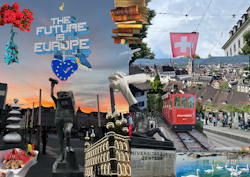
By Jona Biba, Universität Zürich
Whilst looking up towards the sky, an airplane passed through. I missed home. This is how I got inspired to take part in this contest to begin with and express myself through what I had been capturing during the past semesters on my camera roll.
The collage consists of bits and pieces of my daily life as a student, random pictures strolling around, enjoying a Belgian waffle or taking the Polybahn and sending everything to my family. Two different cities and even more different from what I was used to, my comfort zone was now long gone.
Even though new beginnings are challenging, KU Leuven welcomed me with open arms, and so did Universität Zürich (UZH). My roots were not diminished; on the contrary, the unique cultural heritage of each place strengthened my confidence and passion. The long lineage of a 600-year-old university (KU Leuven) taught me patience and wisdom. The first democratically established university in Europe (UZH) taught me about the art of communication. The academic arena is a place that shapes our understanding and impacts the community. This is why today I am very glad to have experienced two diverse systems with one goal, that of empowering students.
The 'University of the Future' is no longer an idea, but a vision that embraces heritage while holding each other's hand. Unity in diversity!
– Jona Biba.
'Juureton', Priya Chakravartty (Helsingin yliopisto/Helsingfors universitet)
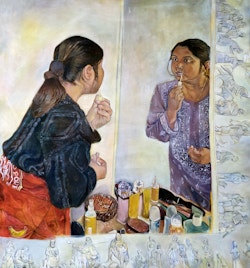
By Priya Chakravartty, Helsingin yliopisto/Helsingfors universitet
Juureton, my oil painting reflects upon my personal journey of identity transformation as an international student from Bengal, India, living and studying in Finland. When I arrived in Helsinki for my master’s degree, I was one of the few people from my country. The shift in my surroundings brought a deep shift within myself. For months, I found myself suspended between two worlds, trying to navigate a new academic and cultural space while holding onto my roots back home.
This sense of in-betweenness of not fully belonging anywhere was both disorienting and formative. The painting is a self-portrait wherein I depict myself wearing student overalls, symbolizing my identity within Finnish university life, as I look at a reflection of myself in a kurti, the outfit I wore to university in Calcutta. The frame draws on the plaster motifs from the University of Helsinki’s main building, embedding local heritage into my personal story.
Through this piece, I explore the idea of alliance not just between nations or institutions, but within the self. The painting becomes a bridge between cultures, identities, and emotions expressing how heritage is not static, but constantly negotiated in our everyday lives as students in an interconnected Europe.
– Priya Chakravartty.
'Still Life in a Residence Hall’s Common Room', Laetitia Van Hecke (KU Leuven)
Laetitia Van Hecke (she/her) is a Korean-Belgian digital artist. She is currently a second-year student in the Una Europa Joint Bachelor of European Studies at KU Leuven, and continues to nurture her lifelong artistic passion on the side. Her Instagram handle is @aelvee.art.

By Laetitia Van Hecke, KU Leuven
'Still Life in a Residence Hall’s Common Room' is a piece inspired by the universal experience of sharing a meal, specifically in the context of university life. The interpersonal relationship formed between students bringing food together after a long day of classes is one that unites us all in the Una Europa community.
Paying tribute to the artistic tradition of the Lower Lands, I was inspired by still lives by masters such as Pieter Claesz, Jan Bruegel the Elder or Clara Peeters and their ability to freeze a moment in time, telling a story through a single image, often featuring food like in my own illustration.
On the table, I have chosen to represent countries such as Belgium, my birthplace and home of KU Leuven, through the cones of fries, or Italy through the pizza. Bread, salad and fruits are relatively international, inviting all sorts of people to join this crossroad of cultures.
Another activity embodying unity and cultural heritage that happens around a table is a game of cards. I have always enjoyed playing board or card games with my friends and relatives, as it’s a fun and engaging way to build relationships. A game of “President” is ongoing at this table; let’s stay at the table a little longer to see who wins.
– Laetitia Van Hecke.
'Untitled', Yana Sheludyakova (Uniwersytet Jagielloński w Krakowie)
Yana finds connections between diverse and unique cultural heritages, expressed through patterns of traditional crafts in scientific cooperation, which is represented by research projects, inventions and scientists who shaped the Europe we live in today.
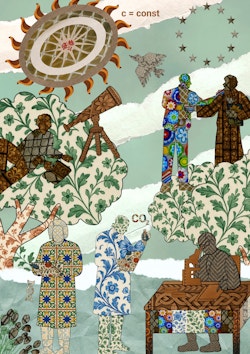
By Yana Sheludyakova, Uniwersytet Jagielloński w Krakowie
This work weighs the legacy of European universities and the collaborations that shaped multiple disciplines across centuries. Her work highlights the discoveries that have transformed science, law.
From Copernicus refining his heliocentric model in Bologna to Clusius transforming botany in Leiden, Grotius laying the foundations of international law, and Einstein and Planck revolutionising physics, the history of knowledge has been written through shared effort.
By connecting these milestones, Yana shows how academic networks have promoted innovation across borders. Later partnerships advanced chemistry, genetics, and law, showing how cooperation between institutions and individuals continually reshapes our understanding of the world.
Today, the Una Europa alliance continues this tradition by uniting 11 universities around collective projects such as Future Unilab. The artwork is both a tribute to this heritage and a call for students to embrace their own identities while finding strength in collaboration, as countless scholars have done before.
– Yana Sheludyakova.
" The Contest gave me the chance to do everything I love: drawing, editing, and researching. In fact, I ended up being carried away much more than I expected, and the research part opened my eyes to the long-standing ties between the member universities. Participating was inspiring, educational, and motivating. "
Yana Sheludyakova shares her experience participating in the Contest.
'The Writing’s On The Wall', Aoife Joy Keogh (University College Dublin/An Coláiste Ollscoile Baile Átha Cliath)
Aoife is a doctoral researcher in Education and Lifelong Learning. Her artwork is an engaged reflection of her own experience and highlights how unity and diversity can open doors for future generations.
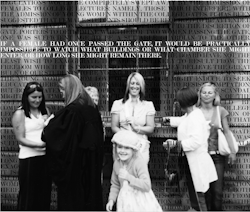
By Aoife Joy Keogh, University College Dublin
From the outset, I knew how I wanted to capture this theme in relation to my own experience of higher education and the ways in which women, both in my own life and historically, have paved the way for me and other young women to thrive in the university space. My artwork seeks to illustrate how the university space can be a powerful tool for individuals to realise their potential, and also affronts those perceiving it with the reality that some groups have historically been excluded from this space.
My piece provides us with the opportunity to consider: who is allowed to occupy the university space in today’s world? What groups continue to be systemically excluded? Through engaging in innovative projects such as this, I hope that we as a society can gain deeper insights into what it means to be part of the university space, consider how we can unite with those whose lived experiences are different from our own, and create space for true alliances of identities in higher education.
– Aoife Joy Keogh.
" When I read about the theme of the contest, ‘Alliance’, it really resonated with me and I felt inspired to create something meaningful. "
Aoife Joy Keogh on her motivation for participating in the Contest.
'A Living Heritage', Cristina García Arranz (University of Edinburgh)
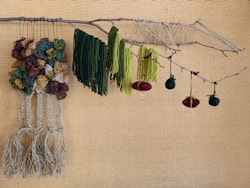
By Cristina García Arranz, University of Edinburgh
The inspiration behind my artwork comes from my view of the university as a place with a rich cultural heritage in continuous evolution. To illustrate this, I decided to create a tree and give a symbolic meaning to each of its constitutive parts.
First, the roots (bottom left) symbolise the deep historical roots of the University of Edinburgh, established in 1582.
Second, the trunk (left) represents the university community, whose diversity of backgrounds, cultures, identities, and experiences gives vitality and colour to the university.
Third, the branches represent the different disciplines taught and researched at the university, each growing and expanding in multiple directions.
Fourth, the green leaves represent the individuals who constitute the university community. Their different shades of green symbolise the continuous renewal of the university community as individuals come and go.
Fifth, the red flowers symbolise moments of blossoming potential and achievement.
Sixth, the dark green fruits represent the contributions brought by the university community to the world.
Lastly, the spider web woven into one of the branches (top right) represents the intricate web of connections formed within the university community and beyond.
To sum up, being part of the University of Edinburgh means being part of a living heritage.
– Cristina García Arranz
'How did I get here?', Caterina Bagioni (Alma Mater Studiorum - Università di Bologna)
This collage tells the story of Caterina's university path through photographs that capture the values, friendships, and places that have shaped her university life.
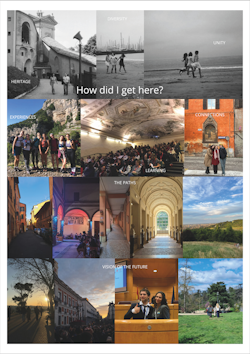
By Caterina Bagioni, Alma Mater Studiorum - Università di Bologna
The experiences I got from Università di Bologna have shaped my understanding of Europe in profound ways. Beyond classrooms and lectures, it has been the friendships I built with people from different backgrounds and cultures that made the biggest impact. These relationships taught me that Europe is not just a political/geographical concept but a reality of exchange, empathy, and shared growth.
My artwork reflects this idea: that Europe’s strength lies in its diversity and in the bonds we form with one another. By bringing together different elements into one piece, I wanted to symbolise how collaboration and friendship create bridges that allow us to grow collectively. I believe that this is the essence of the 'University of the Future', a place where knowledge is enriched by personal connections, mutual support, and cultural openness.
– Caterina Bagioni
" Participating in the contest was a creative, inspiring, and reflecting experience because Una Europa, to me, represents an international and innovative vision that shaped my academic journey and I am very grateful for this opportunity. "
Caterina reflects on her experience with the Visual Art Contest.
'Visage aux mille visages', Quentin Manigler (Université Paris 1 Panthéon-Sorbonne)
In this piece, Quentin uses collage to question identity as something fluid, and constantly reshaped by experiences. The face invites viewers to reflect on their own journeys while also confronting their relationship with the other.
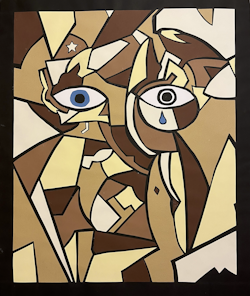
By Quentin Manigler, Université Paris 1 Panthéon-Sorbonne
Through this collage, I wanted to question our relationship with identity, which is always the product of blending. Fragmented, like those pieces of paper in different colours, which nevertheless come together to sketch the shape of a face. In the centre, the eyes look at the viewer, as if to invite each and every one of us to reflect on our own identity, but also on our relationship with the Other, for this face belongs to everyone and to no one at once. To make the connection with Una Europa, I thought of presenting this collage as a metaphor for alliance: together, we form the face of a diverse yet united youth, one that aspires to dialogue and to peace.
– Quentin Manigler
'What is the plural of home?', Aruzhan Tagayeva (Universidad Complutense de Madrid)
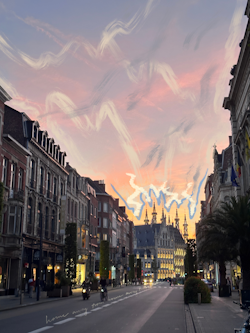
By Aruzhan Tagayeva, Universidad Complutense de Madrid
My submission is a digitally illustrated photograph I took in Leuven on 8 October 2023, during my first semester at KU Leuven. It captures the familiar curve of Bondgenotenlaan – a street I’ve walked a thousand times – at sunset. Turned upside down, the city skyline mirrors the Alatau Mountains: my own visual bridge between past and present. I also added the phrase 'home away from home away from home' to express the layered feeling of belonging and distance. Leuven – who would have imagined – is now a second home, yet the sense of 'away' keeps me grounded in who I am and open to who I’m becoming.
On my Una Europa journey, I’ve come to see unity and heritage as complementary concepts that enrich each other. I found parts of myself in fellow Kazakh students, in late-night talks over tea; in Azerbaijani friends from university, discovering shared Turkic roots during a Nauryz celebration in Brussels; during the study sessions, where our discussions with my Estonian friend spanned ideologies and continents; in dancing to flamenco rhythms, which I recently fell in love with, in my room in Madrid after classes; in the languages I spoke – Kazakh, Russian, Korean, English, German – not as tools, but as vessels of memory, connection, and belonging. These are the bits and pieces that now belong to me, that define me.
Academia has been the bridge. And through it, I’ve come to understand that this shared experience – these people, places, and perspectives – is not just shaping my worldview. They are becoming a part of my heritage.
– Aruzhan Tagayeva.
What's next for the Student Visual Art Contest and our winners?
Exhibitions showcasing the winning artworks will take place in the following Una Europa partner universities during the 2025–2026 academic year:
Universidad Complutense de Madrid: 21–31 October in the hall of the Edificio de Estudiantes (Ciudad Universitaria)
Universität Zürich: 3–14 November at the main entrance of the UZH Zentrum building
Université Paris 1 Panthéon Sorbonne: 25 November – 19 December in the Galerie Soufflot, Centre Panthéon
Uniwersytet Jagielloński w Krakowie: 17 November – end of February in the Biblioteka Jagiellońska
Alma Mater Studiorum – Università di Bologna
Helsingin yliopisto/Helsingfors universitet
KU Leuven
Universidad Complutense de Madrid will kick of the exhibitions on 21 October, as part of the Una Europa General Assembly programme
The Contest winners will travel to the Una Europa Student Congress 2025 taking place this November at Université Paris 1 Panthéon-Sorbonne, during which the Parisian version of the exhibition will be held.

The Una Europa Student Visual Art Contest was designed and implemented by a group of dedicated students from the Una Europa Local Student Task Forces. The Contest was developed in the framework of the Una Europa Student Award, part of the alliance's work to empower students across our alliance, initiated under the Una.Futura project.





